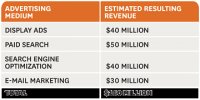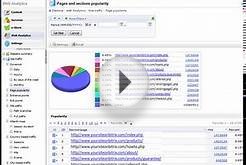 Artwork: The Office of Creative Research (Mark Hansen & Ben Rubin), Moveable Type, 2008, Vacuum-fluorescent display screens, each 8″ x 5″, New York Times building lobby; sentences and phrases that have appeared in the Times
Artwork: The Office of Creative Research (Mark Hansen & Ben Rubin), Moveable Type, 2008, Vacuum-fluorescent display screens, each 8″ x 5″, New York Times building lobby; sentences and phrases that have appeared in the Times
One of our clients, a consumer electronics giant, had long gauged its advertising impact one medium at a time. As most businesses still do, it measured how its TV, print, radio, and online ads each functioned independently to drive sales. The company hadn’t grasped the notion that ads increasingly interact. For instance, a TV spot can prompt a Google search that leads to a click-through on a display ad that, ultimately, ends in a sale. To tease apart how its ads work in concert across media and sales channels, our client recently adopted new, sophisticated data-analytics techniques. The analyses revealed, for example, that TV ate up 85% of the budget in one new-product campaign, whereas YouTube ads—a 6% slice of the budget—were nearly twice as effective at prompting online searches that led to purchases. And search ads, at 4% of the company’s total advertising budget, generated 25% of sales. Armed with those rich findings and the latest predictive analytics, the company reallocated its ad dollars, realizing a 9% lift in sales without spending a penny more on advertising.
That sort of insight represents the holy grail in marketing—knowing precisely how all the moving parts of a campaign collectively drive sales and what happens when you adjust them. Until recently, the picture was fuzzy at best. Media-mix modeling, introduced in the early 1980s, helped marketers link scanner data with advertising and decide how to allocate marketing resources. For about 20 years, everyone gorged on this low-hanging fruit, until the advent of digital marketing in the late 1990s. With the ability to monitor every mouse click, measuring the cause-and-effect relationship between advertising and purchasing became somewhat easier. Marketers started tracking a consumer’s most recent action online—say, a click on a banner ad—and attributing a purchase behavior to it.
Combined with a handful of time-honored measurement techniques—consumer surveys, focus groups, media-mix models, and last-click attribution—such outmoded methods have lulled many marketers into complacency. They mistakenly think they have a handle on how their advertising actually affects behavior and drives revenue. But that approach is backward-looking: It largely treats advertising touch points—in-store and online display ads, TV, radio, direct mail, and so on—as if each works in isolation. Making matters worse, different teams, agencies, and media buyers operate in silos and use different methods of measurement as they compete for the same resources. This still-common practice, what we call swim-lane measurement, explains why marketers often misattribute specific outcomes to their marketing activities and why finance tends to doubt the value of marketing. (See the exhibit “Get Out of Your Swim Lanes.”) As one CFO of a Fortune 200 company told me, “When I add up the ROIs from each of our silos, the company appears twice as big as it actually is.”
 Today’s consumers are exposed to an expanding, fragmented array of marketing touch points across media and sales channels. Imagine that while viewing a TV spot for a Toyota Camry, a consumer uses her mobile device to Google “sedans.” Up pops a paid search link for Camry, as well as car reviews. She clicks through to Car and Driver’s website to read some reviews, and while perusing, she notices a display ad from a local dealership but doesn’t click on it. One review contains a link to YouTube videos people have made about their Camrys. On YouTube she also watches Toyota’s clever “Camry Reinvented” Super Bowl ad from eight months earlier. During her commute to work that week she sees a Toyota billboard she hadn’t noticed before and then receives a direct-mail piece from the company offering a time-limited deal. She visits local dealerships’ websites, including those promoted on Car and Driver and in the direct-mail piece, and at last heads to a dealer, where she test-drives the car and buys it.
Today’s consumers are exposed to an expanding, fragmented array of marketing touch points across media and sales channels. Imagine that while viewing a TV spot for a Toyota Camry, a consumer uses her mobile device to Google “sedans.” Up pops a paid search link for Camry, as well as car reviews. She clicks through to Car and Driver’s website to read some reviews, and while perusing, she notices a display ad from a local dealership but doesn’t click on it. One review contains a link to YouTube videos people have made about their Camrys. On YouTube she also watches Toyota’s clever “Camry Reinvented” Super Bowl ad from eight months earlier. During her commute to work that week she sees a Toyota billboard she hadn’t noticed before and then receives a direct-mail piece from the company offering a time-limited deal. She visits local dealerships’ websites, including those promoted on Car and Driver and in the direct-mail piece, and at last heads to a dealer, where she test-drives the car and buys it.
Toyota’s chief marketing officer should ask two questions: How did this combination of ad exposures interact to influence this consumer? Is Toyota investing the right amounts at the right points in the customer-decision journey to spark her to action?
Data Deluge
Seismic shifts in both technology and consumer behavior during the past decade have produced a granular, virtually infinite record of every action consumers take online. Add to that the oceans of data from DVRs and digital set-top boxes, retail checkout, credit card transactions, call center logs, and myriad other sources, and you find that marketers now have access to a previously unimaginable trove of information about what consumers see and do.
The opportunity is clear, but so is the challenge. As the celebrated statistician and writer Nate Silver put it, “Every day, three times per second, we produce the equivalent of the amount of data that the Library of Congress has in its entire print collection. Most of it is…irrelevant noise. So unless you have good techniques for filtering and processing the information, you’re going to get into trouble.”









